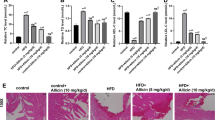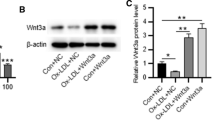Abstract
Background and Purpose
SIRT1 was associated with AS risk and EPCs were reported to participate in the endothelial repair in Coronary Atherosclerosis (CAS). In this study, we explored the role of SIRT1 in AS mice and also its modulation in EPCs.
Methods and Materials
ApoE−/−mice were fed on high-fat and high-glucose diet to establish the AS animal model with the normally-raised C57BL/6 mice as a control group. SIRT1 activator, SRT 2104 was injected intravenously into 5 ApoE−/−mice and its inhibitor Nicotinamide was injected in tail in another 5 ApoE−/− mice. Weight changes were recorded. Blood samples were taken from posterior orbital venous plexus and were detected by automatic biochemical analyzer. HE staining displayed the pathological conditions while Immunohistochemistry (IHC) evaluated the CD34+/VEGFR2+ relative density in the aorta tissues. EPCs were isolated from bone marrow and verified using immunofluorescence staining (IFS). The modulatory mechanism of SIRT1 in EPCs were studied by using RT-PCR, MTT, Western Blot and colony formation, scratch methods.
Results
SIRT1 activator negatively regulated the weight and TC, TG and LDL levels, alleviated the lesion conditions and decreased the CD34+/VEGFR2+ density compared to the AS control. In vitro, SIRT1 activator promoted the proliferation and migration of EPCs and activated wnt/β-catenin/GSK3β signaling pathway. SIRT1 activator also inhibited the autophagy biomarkers ATG1 and LC3II. Furthermore, inhibitor of autophagy promoted SIRT1 expression and induced EPC proliferation, migration and activated wnt/β-catenin/GSK3β pathway. The suppression of the wnt/β-catenin/GSK3β pathway inhibited SIRT1 expression in EPCs, attenuated the proliferation and migration and promoted autophagy of EPCs.
Conclusion
SIRT1 activation might be protective in AS mice through autophagy inhibition in EPCs via wnt/β-catenin/GSK3β signaling pathway.






Similar content being viewed by others
Availability of data and material
All data are provided in this study and raw data can be requested to corresponding author.
References
Iida M, Harada S, Takebayashi T. Application of Metabolomics to Epidemiological Studies of Atherosclerosis and Cardiovascular Disease. Journal of atherosclerosis and thrombosis. 2019;26:747–57.
Tesfamariam B. Endothelial Repair and Regeneration Following Intimal Injury. Journal of cardiovascular translational research. 2016;9:91–101.
Watt J, Kennedy S, Ahmed N, Hayhurst J, McClure JD, Berry C, et al. The relationship between oxidised LDL, endothelial progenitor cells and coronary endothelial function in patients with CHD. Open heart. 2016;3:e000342.
Huang PH, Chen JW, Lin SJ. Effects of Cardiovascular Risk Factors on Endothelial Progenitor Cell. Acta Cardiologica Sinica. 2014;30:375–81.
Blum A, Adawi M. Rheumatoid arthritis (RA) and cardiovascular disease. Autoimmunity reviews. 2019;18:679–90.
Lee PS, Poh KK. Endothelial progenitor cells in cardiovascular diseases. World journal of stem cells. 2014;6:355–66.
Fujita Y, Kawamoto A. Stem cell-based peripheral vascular regeneration. Advanced drug delivery reviews. 2017;120:25–40.
Alexandru N, Safciuc F, Constantin A, Nemecz M, Tanko G, Filippi A, et al. Platelets of Healthy Origins Promote Functional Improvement of Atherosclerotic Endothelial Progenitor Cells. Frontiers in pharmacology. 2019;10:424.
Pelliccia F, Pasceri V, Moretti A, Tanzilli G, Speciale G, Gaudio C. Endothelial progenitor cells predict long-term outcome in patients with coronary artery disease: Ten-year follow-up of the PROCREATION extended study. International journal of cardiology. 2020;318:123–5.
Ndunda P, Vindhyal MR, Muutu T, Fanari Z. Clinical Outcomes of the Dual-Therapy CD34 Antibody-Covered Sirolimus-Eluting Stent Versus Standard Drug-Eluting Coronary Stents: A Meta-Analysis. Cardiovascular revascularization medicine: including molecular interventions. 2020;21:213–21.
Ravindranath RR, Romaschin A, Thompson M. In vitro and in vivo cell-capture strategies using cardiac stent technology — A review. Clinical biochemistry. 2016;49:186–91.
He X, Zheng J, Liu C. Low serum level of sirtuin 1 predicts coronary atherosclerosis plaques during computed tomography angiography among an asymptomatic cohort. Coronary artery disease. 2019;30:621–5.
Breitenstein A, Wyss CA, Spescha RD, Franzeck FC, Hof D, Riwanto M, et al. Peripheral blood monocyte Sirt1 expression is reduced in patients with coronary artery disease. PloS one. 2013;8:e53106.
Hsu CP, Odewale I, Alcendor RR, Sadoshima J. Sirt1 protects the heart from aging and stress. Biological chemistry. 2008;389:221–31.
Wang YQ, Cao Q, Wang F, Huang LY, Sang TT, Liu F, et al. SIRT1 Protects Against Oxidative Stress-Induced Endothelial Progenitor Cells Apoptosis by Inhibiting FOXO3a via FOXO3a Ubiquitination and Degradation. Journal of cellular physiology. 2015;230:2098–107.
Huang S, Zhan Z, Li L, Guo H, Yao Y, Feng M, et al. LINC00958-MYC positive feedback loop modulates resistance of head and neck squamous cell carcinoma cells to chemo- and radiotherapy in vitro. OncoTargets and therapy. 2019;12:5989–6000.
Jiang Q, Hao R, Wang W, Gao H, Wang C. SIRT1/Atg5/autophagy are involved in the antiatherosclerosis effects of ursolic acid. Molecular and cellular biochemistry. 2016;420:171–84.
Hassanpour M, Rezabakhsh A, Pezeshkian M, Rahbarghazi R, Nouri M. Distinct role of autophagy on angiogenesis: highlights on the effect of autophagy in endothelial lineage and progenitor cells. Stem cell research & therapy. 2018;9:305.
Wang C, Mao C, Lou Y, Xu J, Wang Q, Zhang Z, et al. Monotropein promotes angiogenesis and inhibits oxidative stress-induced autophagy in endothelial progenitor cells to accelerate wound healing. Journal of cellular and molecular medicine. 2018;22:1583–600.
Lee HW, Lee SJ, Lee MY, Park MW, Kim SS, Shin N, et al. Enhanced cardiac expression of two isoforms of matrix metalloproteinase-2 in experimental diabetes mellitus. PloS one. 2019;14:e0221798.
Wang X, Zhang C, Gong M, Jiang C. A Novel Identified Long Non-coding RNA, lncRNA MEF2C-AS1, Inhibits Cervical Cancer via Regulation of miR-592/RSPO1. Frontiers in molecular biosciences. 2021;8:687113.
Rana D, Kumar A, Sharma S. Endothelial Progenitor Cells as Molecular Targets in Vascular Senescence and Repair. Current stem cell research & therapy. 2018;13:438–46.
Peters EB. Endothelial Progenitor Cells for the Vascularization of Engineered Tissues. Tissue engineering Part B, Reviews. 2018;24:1–24.
Heidarzadeh M, Roodbari F, Hassanpour M, Ahmadi M, Saberianpour S, Rahbarghazi R. Toll-like receptor bioactivity in endothelial progenitor cells. Cell and tissue research. 2020;379:223–30.
Guerra G, Perrotta F, Testa G. Circulating Endothelial Progenitor Cells Biology and Regenerative Medicine in Pulmonary Vascular Diseases. Current pharmaceutical biotechnology. 2018;19:700–7.
Pías-Peleteiro J, Campos F, Perez-Mato M, Lopez-Arias E, Rodriguez-Yanez M, Castillo J, et al. Endothelial Progenitor Cells as a Therapeutic Approach for Intracerebral Hemorrhage. Current pharmaceutical design. 2017;23:2238–51.
Coppolino G, Cernaro V, Placida G, Leonardi G, Basile G, Bolignano D. Endothelial Progenitor Cells at the Interface of Chronic Kidney Disease: From Biology to Therapeutic Advancement. Current medicinal chemistry. 2018;25:4545–51.
Pyšná A, Bém R, Němcová A, Fejfarová V, Jirkovská A, Hazdrová J, et al. Endothelial Progenitor Cells Biology in Diabetes Mellitus and Peripheral Arterial Disease and their Therapeutic Potential. Stem cell reviews and reports. 2019;15:157–65.
Pelliccia F, Pasceri V, Rosano G, Pristipino C, Roncella A, Speciale G, et al. Endothelial progenitor cells predict long-term prognosis in patients with stable angina treated with percutaneous coronary intervention: five-year follow-up of the PROCREATION study. Circulation journal: official journal of the Japanese Circulation Society. 2013;77:1728–35.
Werner N, Kosiol S, Schiegl T, Ahlers P, Walenta K, Link A, et al. Circulating endothelial progenitor cells and cardiovascular outcomes. The New England journal of medicine. 2005;353:999–1007.
Otto S, Nitsche K, Jung C, Kryvanos A, Zhylka A, Heitkamp K, et al. Endothelial progenitor cells and plaque burden in stented coronary artery segments: an optical coherence tomography study six months after elective PCI. BMC cardiovascular disorders. 2017;17:103.
Morrone D, Felice F, Scatena C, De Martino A, Picoi MLE, Mancini N, et al. Role of circulating endothelial progenitor cells in the reparative mechanisms of stable ischemic myocardium. International journal of cardiology. 2018;257:243–6.
Gui YJ, Xiang QY, Chen JY, Wang YT, Hu JH, Chen YY, et al. Stable coronary artery disease and endothelial progenitor cells. International journal of cardiology. 2018;260:18.
Morrone D, Felice F, Scatena C, De Martino A, Picoi MLE, Mancini N, et al. Reply letter to Dr. Xu et al. on role of circulating endothelial progenitor cells in the reparative mechanisms of stable ischemic myocardium. International journal of cardiology. 2018;260:21.
Hristov M, Erl W, Weber PC. Endothelial progenitor cells: mobilization, differentiation, and homing. Arteriosclerosis, thrombosis, and vascular biology. 2003;23:1185–9.
Balbarini A, Barsotti MC, Di Stefano R, Leone A, Santoni T. Circulating endothelial progenitor cells characterization, function and relationship with cardiovascular risk factors. Current pharmaceutical design. 2007;13:1699–713.
Hammadah M, Samman Tahhan A, Mheid IA, Wilmot K, Ramadan R, Kindya BR, et al. Myocardial Ischemia and Mobilization of Circulating Progenitor Cells. Journal of the American Heart Association. 2018;7:e007504.
Lamichane S, Baek SH, Kim YJ, Park JH, Dahal Lamichane B, Jang WB, et al. MHY2233 Attenuates Replicative Cellular Senescence in Human Endothelial Progenitor Cells via SIRT1 Signaling. Oxidative medicine and cellular longevity. 2019;2019:6492029.
Xiao J, Lu Y, Yang X. THRIL mediates endothelial progenitor cells autophagy via AKT pathway and FUS. Molecular medicine (Cambridge, Mass). 2020;26:86.
Zhang L, Yu Y, Xia X, Ma Y, Chen XW, Ni ZH, et al. Transcription factor E2-2 inhibits the proliferation of endothelial progenitor cells by suppressing autophagy. International journal of molecular medicine. 2016;37:1254–62.
Ming GF, Wu K, Hu K, Chen Y, Xiao J. NAMPT regulates senescence, proliferation, and migration of endothelial progenitor cells through the SIRT1 AS lncRNA/miR-22/SIRT1 pathway. Biochemical and biophysical research communications. 2016;478:1382–8.
Walter DH, Zeiher AM, Dimmeler S. Effects of statins on endothelium and their contribution to neovascularization by mobilization of endothelial progenitor cells. Coronary artery disease. 2004;15:235–42.
Everaert BR, Van Craenenbroeck EM, Hoymans VY, Haine SE, Van Nassauw L, Conraads VM, et al. Current perspective of pathophysiological and interventional effects on endothelial progenitor cell biology: focus on PI3K/AKT/eNOS pathway. International journal of cardiology. 2010;144:350–66.
Wang J, Ren XR, Piao H, Zhao S, Osada T, Premont RT, et al. Niclosamide-induced Wnt signaling inhibition in colorectal cancer is mediated by autophagy. The Biochemical journal. 2019;476:535–46.
Petherick KJ, Williams AC, Lane JD, Ordóñez-Morán P, Huelsken J, Collard TJ, et al. Autolysosomal β-catenin degradation regulates Wnt-autophagy-p62 crosstalk. The EMBO journal. 2013;32:1903–16.
Nàger M, Sallán MC, Visa A, Pushparaj C, Santacana M, Macià A, et al. Inhibition of WNT-CTNNB1 signaling upregulates SQSTM1 and sensitizes glioblastoma cells to autophagy blockers. Autophagy. 2018;14:619–36.
Azoulay-Alfaguter I, Elya R, Avrahami L, Katz A, Eldar-Finkelman H. Combined regulation of mTORC1 and lysosomal acidification by GSK-3 suppresses autophagy and contributes to cancer cell growth. Oncogene. 2015;34:4613–23.
Funding
Funding: This work was supported by National Natural Science Foundation of China (Grant No. 81970303) Jinzhou science and technology guiding plan project (JZ2020B011) Horizontal scientific research project of Jinzhou Medical.
Author information
Authors and Affiliations
Contributions
Yanwei Li- Literature search, DesignData, analysis, Statistical analysis, Manuscript review. Wei Cui- Concepts, Design, Data acquisition, Manuscript editing. Bing Song- Definition of intellectual content, Literature search. Xuying Ye-Experimental studies. Zhuqing Li- Manuscript preparation. Chengzhi Lu- Manuscript preparation, Manuscript review, Guarantor.
Corresponding author
Ethics declarations
Ethical approval was obtained from Institutional ethical review Board (IEC) of The First Affiliated Hospital of Jinzhou Medical University, Jinzhou City, Liaoning Province, China. Informed consent was obtained from the participants with the option to withdraw them from the study at any time. This work was supported by National Natural Science Foundation of China (Grant No. 81970303); Jinzhou science and technology guiding plan project (JZ2020B011); Horizontal scientific research project of Jinzhou Medical University; Project No. 2021007.
Additional information
Conflict of Interest
No conflict of interest was found or declared by any of authors.
Consent for publication
IEC of The First Affiliated Hospital, Jinzhou City, Liaoning Province, China affiliated to of Jinzhou Medical University, approved the publication of data generated from this study.
Rights and permissions
About this article
Cite this article
Li, Y., Cui, W., Song, B. et al. Autophagy-Sirtuin1(SIRT1) Alleviated the Coronary Atherosclerosis (AS) in Mice through Regulating the Proliferation and Migration of Endothelial Progenitor Cells (EPCs) via wnt/β-catenin/GSK3β Signaling Pathway. J Nutr Health Aging 26, 297–306 (2022). https://doi.org/10.1007/s12603-022-1750-7
Received:
Accepted:
Published:
Issue Date:
DOI: https://doi.org/10.1007/s12603-022-1750-7




